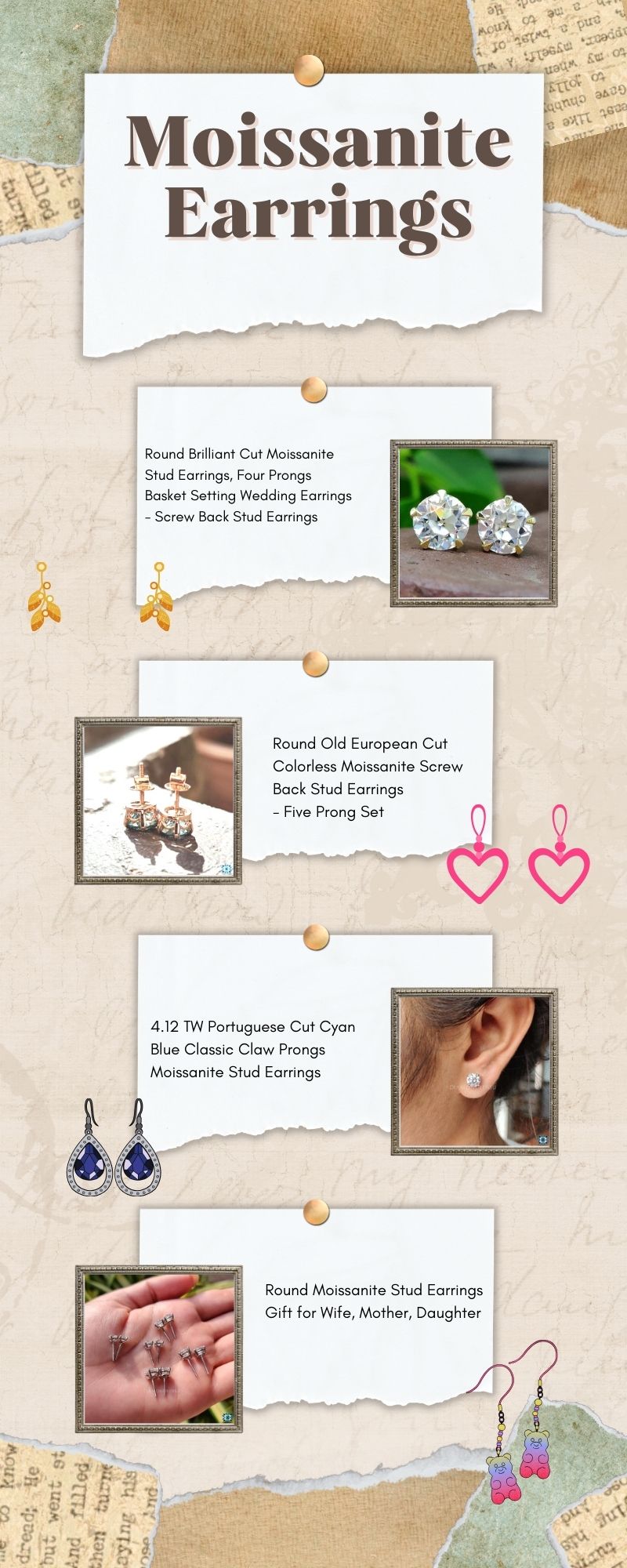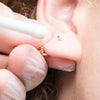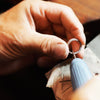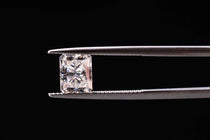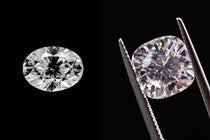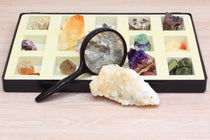Determining the authenticity of diamond earrings can be pivotal, especially considering the value and sentiment often attached to such fine jewelry. Knowing whether your diamond is real or fake not only influences its monetary worth but also its heirloom quality and the care it requires. With a proliferation of clever imitations on the market, it’s important to equip yourself with reliable methods to assess your diamond earrings' authenticity.
The physical characteristics of a genuine diamond are distinct, and several at-home tests can help confirm the legitimacy of your jewelry. These tests hinge on a diamond's remarkable properties, which include exceptional hardness, high refractive index, and superior thermal conductivity. However, it's important to be aware that some synthetic alternatives can closely mimic these properties, so these methods are not foolproof.
For a more definitive assessment, professionals use specialized equipment that can accurately distinguish between real and fake diamonds. When in doubt, it is prudent to consult with a certified gemologist or a reputable jeweler. They can provide authoritative verification, ensuring that the value and authenticity of your diamond earrings are beyond question.
Understanding Diamond Properties
To accurately determine the authenticity of diamond earrings, it's essential to understand the key characteristics of diamonds, including how natural diamonds differ from synthetic ones, hardness ratings on the Mohs scale, and the importance of grades and certifications.
Natural vs Synthetic Diamonds
| Characteristic | Natural Diamonds | Synthetic Diamonds |
|---|---|---|
| Formation | Formed naturally over millions to billions of years under high pressure and temperature deep within the Earth's mantle. | Created in a laboratory using high-pressure, high-temperature (HPHT) or chemical vapor deposition (CVD) methods. |
| Origin | Mined from diamond deposits around the world. | Produced in controlled environments using advanced technological processes. |
| Cost | Generally more expensive due to the rarity and natural formation process. | Can be more affordable compared to natural diamonds, depending on the production method and quality. |
| Quality Control | Natural diamonds may have natural inclusions and variations in color, requiring careful grading. | Can be created with fewer or no inclusions, offering more control over the diamond's characteristics. |
| Environmental Impact | Mining natural diamonds can have environmental consequences, including habitat disruption and carbon emissions. | Considered a more environmentally friendly option as it reduces the demand for diamond mining. |
| Traceability | Each natural diamond has a unique geological history, but traceability can be challenging in the supply chain. | Lab-grown diamonds can be traced back to their origin and production process more easily. |
| Size Availability | Available in a wide range of sizes, with larger diamonds being more rare and valuable. | Can be produced in various sizes, and larger diamonds may be more accessible. |
| Market Acceptance | Widely accepted and valued in the jewelry market for their rarity and natural beauty. | Increasing acceptance, especially as technology improves and consumers seek ethical and sustainable options. |
| Optical and Physical Properties | Natural diamonds may have unique characteristics and imperfections, contributing to their individual beauty. | Lab-grown diamonds can exhibit similar optical and physical properties, but may lack natural imperfections. |
Natural diamonds are formed over billions of years under high-pressure, high-temperature conditions deep within the Earth. Synthetic diamonds, also known as lab-grown or lab-created diamonds, are made through technological processes that mimic natural conditions, resulting in a stone with properties identical to that of a mined diamond. While both share the same chemical composition, identification can often be made through specialized equipment analyzing for minor differences in inclusion patterns and crystal growth.
Diamonds and the Mohs Scale of Hardness
The Mohs scale of hardness is a qualitative ordinal scale that characterizes the scratch resistance of various minerals through the ability of a harder material to scratch a softer one. Diamonds are at the top of this scale with a rating of 10, indicating they are the hardest known mineral. This property means that a real diamond should not be scratch-able by substances with a lower rating on the scale.
Grades and Certifications
Grading reports or certifications from reputable organizations like the Gemological Institute of America (GIA) or the International Gemological Institute (IGI) play a crucial role in establishing authenticity. These certifications assess various aspects of a diamond, including the Four Cs (Cut, Color, Clarity, and Carat weight). Certified diamonds come with documentation providing proof of the gemstone's natural origin and qualities, distinguishing them from synthetic counterparts that might not carry the same level of certification.
Visual Inspection Tests

Conducting a visual inspection is a crucial first step in determining whether your diamond earrings are genuine. By using specific tools and understanding what to look for, you can identify key characteristics that indicate the authenticity of your jewelry.
Using a Loupe to Spot Inclusions
A jeweler's loupe is a small magnification device that allows you to closely examine your diamond for inclusions or imperfections. Real diamonds often have tiny imperfections. When inspecting with a loupe, you should look for small flaws or irregularities within the gemstone, which are typically absent in counterfeit diamonds.
Examining Refracted Light and Brilliance
Real diamonds exhibit a high degree of brilliance and fire. Observe how light passes through the earring and reflects off its surfaces. A genuine diamond will refract light in such a way that it sparkles intensely, while a fake may have duller sparkle. Be mindful of the colors reflected; real diamonds create a rainbow of colors due to their high dispersion.
Identifying Hallmarks and Stamps
Precious metals like platinum, gold, and silver are commonly used in genuine diamond jewelry and are often stamped with hallmarks indicating the quality. Check for stamps such as "950" for platinum, "18K" for yellow gold, "14K" for white gold, or "925" for sterling silver. A stamp of "PL" or a specific number like "750" often signifies high-quality precious metal content, which is typical in real diamond earrings.
Physical Test Methods
When assessing the authenticity of diamond earrings, employing simple physical test methods can often provide preliminary insight. These tests are designed to evaluate the material properties that distinguish a real diamond from fakes like glass, cubic zirconia, or other simulants.
The Fog Test
To perform the fog test, hold your diamond earring between two fingers and breathe hot air onto its surface, as if you are fogging up a mirror. A real diamond won't retain the fog due to its high thermal conductivity which disperses heat quickly. However, if the fog lingers for a few seconds, it could indicate that the stone is not a real diamond.
Water and Density Tests
For the water test, drop the earring into a glass of water. A real diamond has a high density and will sink to the bottom swiftly, whereas many fake diamonds and other simulants like cubic zirconia or glass will float or sink more slowly. Remember, this test can be risky if the stone is not mounted securely. The density test involves weighing your diamond and calculating its density by comparing the weight to the volume of water displaced. The specific gravity for a true diamond is approximately 3.52 g/cm³.
Scratch Test
Utilize the scratch test with caution. A real diamond can scratch glass due to its impressive hardness. Gently drag your diamond across a mirror: if it leaves a mark, the stone could be real. Be aware that other hard materials like cubic zirconia or zircon can also scratch glass, making this method less conclusive without additional tests.
Advanced Testing Equipment

When determining the authenticity of a diamond earring, specialized testing equipment can provide definitive answers that visual inspection alone cannot. These advanced tools measure various properties of the stone that are difficult or impossible to fake.
Thermal Conductivity Probes
A diamond tester is a handheld device that applies a thermal conductivity test to determine if your diamond earring is authentic. Diamonds have high thermal conductivity, which means they disperse heat quickly. By contrast, most diamond simulants do not disperse heat as effectively. When you press a thermal conductivity probe against the stone, an authentic diamond will conduct heat rapidly and give a positive reading.
Testing for Electrical Conductivity
Another accurate method to differentiate between diamond and its most convincing simulant, moissanite, involves an electrical conductivity test. While diamonds are known principally for their thermal properties, moissanite is uniquely conductive. If you conduct this test and the device signals high electrical conductivity, it's indicative that the stone might be moissanite rather than a real diamond.
UV Light Examination
Exposure to UV light can reveal the fluorescence in a diamond, giving you a clue about its authenticity. Place your diamond under a black light and look for blue fluorescence. Moderate to strong blue suggests that the diamond is real. However, the absence of fluorescence does not necessarily indicate a fake since some genuine diamonds do not fluoresce.
Professional Appraisal and Verification

When determining the authenticity of diamond earrings, professional appraisal and verification are paramount. By seeking expert assistance, understanding gemological certifications, and knowing the appraisal process, you can ascertain the worth and authenticity of your diamond jewelry.
Seeking Assistance from Reputable Jewelers
Reputable jewelers with credentials from recognized institutions, like the Gemological Institute of America (GIA), are your go-to professionals for appraising diamond earrings. They have the expertise to inspect loose diamonds and mounted diamonds alike. They will use specialized tools such as loupes, microscopes, and possibly electronic testers to examine the quality and characteristics of the stones within your jewelry.
Interpreting Gemological Certifications
A GIA certification is a document that provides a reliable and accurate assessment of a diamond's characteristics. When a diamond is certified, the GIA has evaluated aspects such as cut, color, clarity, and carat weight. Your earring's diamond should come with this certification, which a reputable jeweler can help you interpret. Authenticity is confirmed by matching the details on the certification with the gemstone.
Understanding Appraisal for Insurance
An appraisal for insurance purposes assesses the value of your diamond earrings for coverage in the event of loss, theft, or damage. This valuation considers the current retail prices and the quality of the diamond and settings. When investing in diamond earrings as an investment, secure an up-to-date appraisal from certified appraisers, as the market for diamonds and diamond alternatives can fluctuate. Ensure the appraisal reflects the true value and authenticity of your real diamond earrings, not just the precious metals or other stones in the jewelry.
Recognizing Common Diamond Simulants
| Simulant | Composition | Physical Properties | Visual Characteristics | Distinguishing Features |
|---|---|---|---|---|
| Cubic Zirconia (CZ) | Zirconium dioxide (ZrO2) | Hardness: 8.5 - 9 Refractive Index: 2.15 - 2.18 |
High brilliance and fire, often lacks some dispersion compared to diamonds. | Double refraction under a loupe; thermal conductivity testing. |
| Moissanite | Silicon carbide (SiC) | Hardness: 9.25 Refractive Index: 2.65 - 2.69 |
High brilliance, strong fire, and double refraction under certain conditions. | Double refraction under a loupe; electrical conductivity testing. |
| White Topaz | Aluminum silicate (Al2SiO4(F,OH)2) | Hardness: 8 Refractive Index: 1.62 - 1.64 |
May lack the fire and brilliance of diamonds, often with a softer appearance. | Lower hardness; lower specific gravity compared to diamonds. |
| White Sapphire | Aluminum oxide (Al2O3) | Hardness: 9 Refractive Index: 1.76 - 1.77 |
May have high brilliance, but tends to be less dispersive than diamonds. | Higher hardness; absence of double refraction. |
| Quartz | Silicon dioxide (SiO2) | Hardness: 7 Refractive Index: 1.54 - 1.55 |
Variable brilliance; may lack the fire and dispersion of diamonds. | Lower hardness; lack of fire and brilliance compared to diamonds. |
When considering diamond stud earrings, it's crucial to discern genuine diamonds from simulants. Simulants can closely resemble real diamonds, but distinct characteristics and tests can reveal their true identity.
Differences Between Diamond and Cubic Zirconia
Cubic zirconia (CZ) is a common diamond simulant. Unlike real diamonds, CZ is heavier and often flawless, given its synthetic origins. Real diamonds typically have minor flaws or inclusions. When inspecting your diamond earrings, look for signs like a high refractive index and a density that’s significantly less in genuine diamonds compared to cubic zirconia.
Other Diamond-like Gemstones
Gemstones such as white topaz, quartz, and white sapphire mimic diamond appearances. White sapphire generally has less brilliance than a real diamond, and quartz and topaz may display more noticeable flaws or chips. They all lack the hardness and specific gravity that characterize real diamonds.
Identifying Moissanite and White Sapphire
Moissanite is another simulant that closely resembles diamonds but has a different refractive index, causing a distinctive, fiery sparkle. Testing for double refraction can separate moissanite from a diamond, which exhibits single refraction. White sapphire is less brilliant and often appears cloudier compared to the sharp and clear appearance of a genuine diamond.
Practical Tips for Buyers

When purchasing diamond earrings, attention to detail can save you from deception. Evaluate craftsmanship, understand pricing nuances, and scrutinize settings to ensure authenticity and value.
Checking for Craftsmanship and Design
Examine the craftsmanship; real diamond earrings showcase impeccable precision. Authentic studs, hoop, or halo designs should have even and precise metal work. A ring or the backing of earrings should be sturdy and well-constructed, often using precious metals like platinum, gold, or silver.
Understanding the Importance of Weight and Price
The carat weight of a diamond correlates directly with its price; expect to pay more for heavier earrings. However, be wary of prices that seem too good to be true, as they often are. Investment in flawless, high-carat diamonds should reflect current market value.
Assessing Different Jewelry Settings
Diamond jewelry settings should secure the stones firmly. Look for settings like prong, bezel, or tension that align properly with the design and structure of the piece. Settings in platinum or gold not only enhance durability but also complement the brilliance of the diamonds.
Frequently Asked Questions
When determining the authenticity of diamond earrings, it's useful to familiarize yourself with some at-home verification methods and key characteristics of genuine diamonds.
What are the at-home methods to verify the authenticity of diamond earrings?
You can perform a few tests at home to check if your diamond earrings are real. One common method is the fog test: breathe directly onto the diamond, and if the fog dissipates quickly, the diamond is likely authentic. Another is to examine the reflections in the diamond; real diamonds will reflect shades of gray inside them.
How can one identify if a diamond mounted in earrings is genuine without specialized equipment?
Observe the diamond for signs of wear; genuine diamonds are very durable and should not exhibit scratches easily. A loupe can aid in checking for imperfections and natural inclusions, which are often present in real diamonds as opposed to many synthetics or simulants.
What kind of water test can be used to determine if diamond earrings are authentic?
For the water test, fill a glass with water and gently drop the earrings inside. Real diamonds have a high density and will sink to the bottom quickly, while fake diamonds may float or sink slowly.
Which markings should be looked for on diamond earrings to ascertain their legitimacy?
Examine the metal of the earring posts and settings for markings that indicate the type of metal; genuine diamonds are typically set in high-quality metals such as gold or platinum, marked as "10K," "14K," "18K," "585," "750," "900," "950," "PT," or "PLAT."
Can the visual properties of a diamond in sunlight help determine if it's real?
Inspect your diamond earrings in sunlight; real diamonds will exhibit a brilliant sparkle with a full spectrum of colors, reflecting the light in a unique way known as "fire," which is less pronounced in fake diamonds.
Is the presence of a stamp or screw-back indicative of the authenticity of diamond earrings?
While a stamp or screw-back on earrings does indicate attention to detail which is often present in authentic pieces, they are not definitive proof of a diamond's authenticity. The absence of markings doesn't necessarily indicate a fake, and some imitations may feature such markings to appear genuine.
Checkout some of our top collections:

